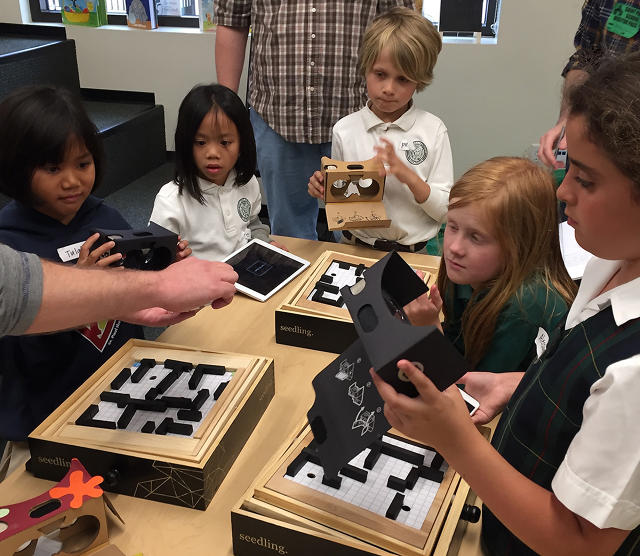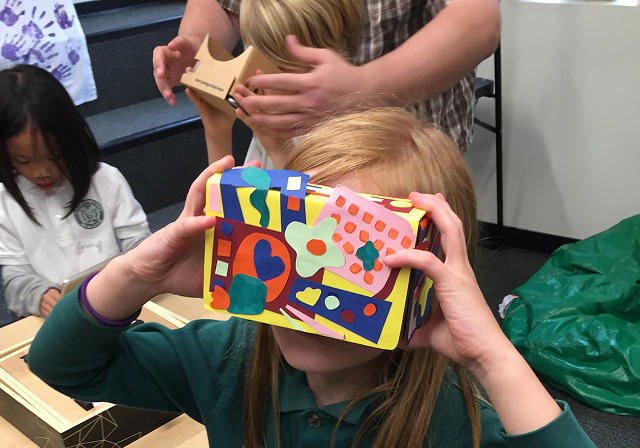Tiptoeing Into The World Of VR For Kids
“What am I supposed to do? How do I start this?”
A second-grader named Yasmine is staring into a cardboard virtual reality headset, moving her head up and down, as she tries to grasp just what it is she’s looking at. What it is, is a maze. Or, rather, a virtual version of a maze that she’s just built by gluing small pieces of wood onto a box with a movable plank and a marble. The maze was then scanned using an iPhone app, and reconfigured digitally. With the phone now plugged into the headset, Yasmine has the sensation that she’s walking through it.
“Whoa!” she says, as the concept starts to sink in. Then a delighted squeal: “Where do I go?!”
It’s no secret that advances in technology are pushing VR well beyond gamers and into areas like education, medicine, and of course, entertainment. Facebook-owned Oculus, Samsung, and Sony PlayStation VR are launching a whole slew of virtual reality content this year, from short films to documentaries to cartoons. But can VR be incorporated into kids’ games? And more importantly, should it, given that most kids are just starting to get a handle on AR (actual reality), let alone digitally re-created reality?
Manufacturers thus far are very clear in specifying that kids’ VR products are for older children, and institutions like Stanford are actively researching the effects of VR on kids—with some concerning results. In 2009, the university’s Virtual Human Interaction Lab published a study based on a group of children that had experienced an underwater simulation of playing with whales via VR. A week later, about half of them said they remembered the experience as though it had actually happened.
These are issues that the Los Angeles-based toy company Seedling has been considering as it has been developing its new VR Maze Activity Kit, which will hit stores later this year and is aimed at kids between the ages of 8 and 12. On a weekday afternoon in April, kids like Yasmine were testing the maze at St. Paul’s School in West L.A. It was the first time that the headset—a cardboard DIY contraption that kids can decorate in different styles, including Matisse-themed cutouts or cross-stitch yarn—had been put in the hands of actual kids, and the company’s executives were eager to witness reactions.

“How does the UI flow? How much help do they need understanding how to use the maze? These are the sorts of things we’re interested in learning,” Seedling’s CEO and founder Phoebe Hayman said, as she sat on a bench watching the kids experiment.
That Hayman, a former competitive ice skater and fine arts and photography major from New Zealand (and mother of two) sounds like a Silicon Valley techie is an irony. Until recently, her company—which she founded in 2007, when she started selling handmade activity sets at a local farmer’s market in New Zealand—has been known for high-quality, DIY arts and crafts kits that let kids make things like feather crowns, birdhouses, and butterfly wings. They’re all “open-ended,” she says, meaning that more than actual toys, they’re ultimately tools that kids use to make whatever they want. One of the company’s best sellers is its superhero kit, which provides materials for making a cape.
“We try to get you to think through it—what’s your character? How are you a superhero?” Hayman says. “What do you stand for? Then we get you to make your own piece that you then play with. The idea that you play with it afterward and it has a function, a use for your child, is important to us. It’s not some trinkety thing that you’re making that falls apart pretty fast.”
Hayman’s play-based approach took off quickly, and soon she was expanding beyond the farmer’s market into local toy stores. Two years ago, Hayman and her family moved to Irvine, California, and Seedling merged with P.S. XO, the e-commerce, kids’ party supply company founded by Kara Nortman and Soleil Moon Frey (of Punky Brewster fame). The new venture raised $7 million from UpFront Ventures and Greycroft Partners. Today, with revenue on track to double from 2015 to 2016, according to the company, Seedling products are sold online and at stores like Barneys, J.Crew, and Harrods in London; a less expensive line for Target launched in March. The products are more craft-oriented than the popular Melissa & Doug line of kids’ playthings, but they share that company’s emphasis on high-quality materials.
So how does cutting-edge technology like VR make sense for a company that’s traditionally more about activities involving yarn and glitter glue? Hayman’s answer is that Seedling is material agnostic. Whether it’s a piece of wood or an iPhone, it’s all about giving kids cool tools to do cool things. Seedling is also about making activities for where and how kids actually play, rather than dictating where they should be playing. And whether parents like it or not, kids like to play with screens.

All of this led the company to start experimenting with VR. “Anything interesting coming up in the tech sector, we’re thinking about,” Hayman says. “How does it apply to play?” There was no outsourcing, Seedling’s engineers simply started fooling around and teaching themselves what they needed to know about the new technology. Within a year, they’d come up with a prototype.
“The idea was, what if you were able to shrink the maze and be able to walk inside of it?” Hayman says. “I think we were probably inspired by things like the ’80s movie, Labyrinth. Everybody wants to be David Bowie!
“And so the idea is, there’s a story you can tell with it—build this maze, which is super cool, but then I can shrink myself into it and it comes to life. VR for us is a perfect form for that.”
There’s also a social component—kids can play together with one person’s maze and even create Selfie avatars that roam around the VR world, so they can see each other as they play.
As for parents’ concerns that children are already too exposed to technology, which starts taking away from more tactile and physical play, Hayman says, “This isn’t about immersion” or having “kids spending hours on a device and not lifting their head up.
“We’re looking at helping children recognize the amazing tool that the device is, but recognizing it as a tool, not as entertainment, not as something you disappear into and never come back. We’re interested in pushing you out of the app, back into the physical world, just as much. So if you want to create a new maze, we want to push you out of the digital and into the physical world just as strongly. And to encourage you to keep creating in a real way and then be able to bring that version to life. The digital piece, to us, in terms of hierarchy of elements—it’s just a piece. It’s a cool thing, but it’s not the point of it.”

Perhaps, but the kids fooling around with the maze at St. Paul’s were definitely very engrossed in the VR portion of the game. With their headsets firmly held on their foreheads, they walked around the room with their hands in front of them like giddy mummies, navigating their faux worlds. There were cries of, “This is like Halo!” and, “I need to win this!” One boy named Albert repeatedly shrieked whenever a spider dropped down in front of him (one of the game’s features), causing Seedling engineers to exchange looks. “Is it too scary?” they asked him.
These are the sorts of issues that will have to be addressed as Seedling ventures into new territory. VR’s heightened reality can feel scary—really scary—even to adults. Where do you draw the line between fun-frightening and terrifying? And how do you maintain a healthy balance between the kind of physically stimulating play that the company has historically encouraged, and the less sensory experience of staring into a pixelated world, even if it’s a world that you created? In other words, how do you get kids to not become totally immersed in something as cool as VR?
Seedling is keenly aware of how sensitive the territory is, and relied on Stanford’s research while developing its Maze. One takeaway was that the headset should be handheld and not strapped on to a child’s head, so that the child could put it on and take it off freely. Seedling also ran a prototype of the Maze by Apple’s kids category manager in early December for feedback. Following the testing day in April, Seedling’s executives and engineers planned on poring over the data and observations they’d gathered about how the kids played with the maze. If things needed to be tweaked or rethought, they’d address the issues. But overall, everyone seemed pleased with how the day went—none more so than the kids, who were reluctant to leave, even as moms and dads started arriving to pick them up.
“I don’t think they want one or the other,” Hayman said of kids’ desire for tech and non-tech experiences. Going back and forth between an actual maze and a VR maze “makes total sense to them. From what we’ve seen with the kids, including my kids—this feels natural.”
Related Video: Will VR Go Mainstream?
Fast Company , Read Full Story
(59)














